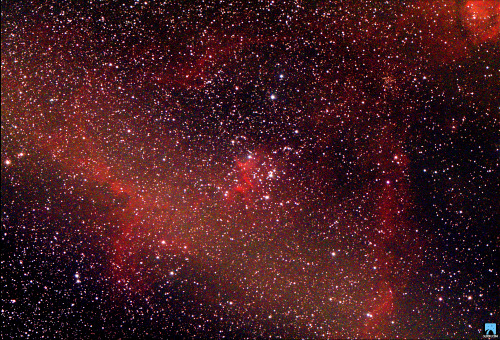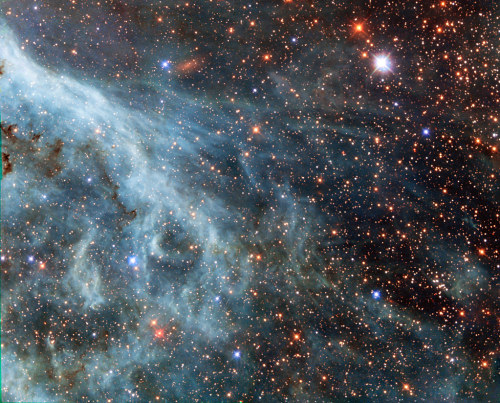𝑵𝒐𝒓𝒕𝒉 𝑨𝒎𝒆𝒓𝒊𝒄𝒂 𝑵𝒆𝒃𝒖𝒍𝒂

𝑵𝒐𝒓𝒕𝒉 𝑨𝒎𝒆𝒓𝒊𝒄𝒂 𝑵𝒆𝒃𝒖𝒍𝒂
This view of the North America nebula combines both visible and infrared light observations, taken by the Digitized Sky Survey and NASA Spitzer Space Telescope. Clusters of young stars about one million years old can be found throughout the image.
More Posts from Shibushiuniverse and Others




Spatial veils of light

This is the Heart Nebula! 💖💖💖
Happy Valentine’s Day! To celebrate this occasion, here is the beautiful Heart Nebula, an emission nebula with dark dust lanes and glowing red hydrogen gas. The heart shape of the nebula is driven by stellar winds from the hot stars inside, some of which have masses up to 50 times the Sun! 💕💕💕
Taken by me (Michelle Park) using the Slooh Canary Two telescope on February 7th, 2022 at 21:13 UTC.

NGC 6995: The Bat Nebula : Do you see the bat? It haunts this cosmic close-up of the eastern Veil Nebula. The Veil Nebula itself is a large supernova remnant, the expanding debris cloud from the death explosion of a massive star. While the Veil is roughly circular in shape and covers nearly 3 degrees on the sky toward the constellation of the Swan (Cygnus), NGC 6995, known informally as the Bat Nebula, spans only ½ degree, about the apparent size of the Moon. That translates to 12 light-years at the Veil’s estimated distance, a reassuring 1,400 light-years from planet Earth. In the composite of image data recorded through narrow band filters, emission from hydrogen atoms in the remnant is shown in red with strong emission from oxygen atoms shown in hues of blue. Of course, in the western part of the Veil lies another seasonal apparition: the Witch’s Broom Nebula. via NASA
-
 spiritgeyed reblogged this · 1 year ago
spiritgeyed reblogged this · 1 year ago -
 ashvin-22 liked this · 2 years ago
ashvin-22 liked this · 2 years ago -
 agains-tthecurrent liked this · 2 years ago
agains-tthecurrent liked this · 2 years ago -
 doofusschweetz liked this · 2 years ago
doofusschweetz liked this · 2 years ago -
 ogunbugundur liked this · 2 years ago
ogunbugundur liked this · 2 years ago -
 nagasarennayoex reblogged this · 2 years ago
nagasarennayoex reblogged this · 2 years ago -
 nagasarennayoex liked this · 2 years ago
nagasarennayoex liked this · 2 years ago -
 bigben1775-blog liked this · 2 years ago
bigben1775-blog liked this · 2 years ago -
 playboisaiyan reblogged this · 2 years ago
playboisaiyan reblogged this · 2 years ago -
 wildwarrior010 liked this · 2 years ago
wildwarrior010 liked this · 2 years ago -
 redlkia liked this · 2 years ago
redlkia liked this · 2 years ago -
 planetaerium reblogged this · 2 years ago
planetaerium reblogged this · 2 years ago -
 planetaerium liked this · 2 years ago
planetaerium liked this · 2 years ago -
 jasmine20131 reblogged this · 2 years ago
jasmine20131 reblogged this · 2 years ago -
 jasmine20131 liked this · 2 years ago
jasmine20131 liked this · 2 years ago -
 kuropatochkaa liked this · 2 years ago
kuropatochkaa liked this · 2 years ago -
 ajthewitch24 liked this · 2 years ago
ajthewitch24 liked this · 2 years ago -
 theforsakenaryai liked this · 2 years ago
theforsakenaryai liked this · 2 years ago -
 thespans liked this · 2 years ago
thespans liked this · 2 years ago -
 thestarsarebrighter liked this · 2 years ago
thestarsarebrighter liked this · 2 years ago -
 somebodyelse-99 liked this · 2 years ago
somebodyelse-99 liked this · 2 years ago -
 julespetiteverne liked this · 2 years ago
julespetiteverne liked this · 2 years ago -
 aaventador liked this · 2 years ago
aaventador liked this · 2 years ago -
 xxmimirxx liked this · 2 years ago
xxmimirxx liked this · 2 years ago -
 shadowoffandoms liked this · 2 years ago
shadowoffandoms liked this · 2 years ago -
 osmar1960 liked this · 2 years ago
osmar1960 liked this · 2 years ago -
 al8ssa liked this · 2 years ago
al8ssa liked this · 2 years ago -
 whydoesthisevenexist liked this · 2 years ago
whydoesthisevenexist liked this · 2 years ago -
 the-last-piece-of-pie liked this · 2 years ago
the-last-piece-of-pie liked this · 2 years ago -
 coldlunax liked this · 2 years ago
coldlunax liked this · 2 years ago -
 earthmoonlotus reblogged this · 2 years ago
earthmoonlotus reblogged this · 2 years ago -
 earthmoonlotus liked this · 2 years ago
earthmoonlotus liked this · 2 years ago -
 freinhardt56 reblogged this · 2 years ago
freinhardt56 reblogged this · 2 years ago -
 etoolcharlie liked this · 2 years ago
etoolcharlie liked this · 2 years ago -
 justyouraverageweird liked this · 2 years ago
justyouraverageweird liked this · 2 years ago -
 shibushiuniverse reblogged this · 2 years ago
shibushiuniverse reblogged this · 2 years ago -
 shibushiuniverse liked this · 2 years ago
shibushiuniverse liked this · 2 years ago -
 demonictreegremlin liked this · 2 years ago
demonictreegremlin liked this · 2 years ago -
 freinhardt56 reblogged this · 2 years ago
freinhardt56 reblogged this · 2 years ago








